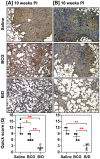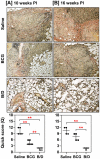A booster vaccine expressing a latency-associated antigen augments BCG induced immunity and confers enhanced protection against tuberculosis
- PMID: 21858087
- PMCID: PMC3157374
- DOI: 10.1371/journal.pone.0023360
A booster vaccine expressing a latency-associated antigen augments BCG induced immunity and confers enhanced protection against tuberculosis
Abstract
Background: In spite of a consistent protection against tuberculosis (TB) in children, Mycobacterium bovis Bacille Calmette-Guerin (BCG) fails to provide adequate protection against the disease in adults as well as against reactivation of latent infections or exogenous reinfections. It has been speculated that failure to generate adequate memory T cell response, elicitation of inadequate immune response against latency-associated antigens and inability to impart long-term immunity against M. tuberculosis infections are some of the key factors responsible for the limited efficiency of BCG in controlling TB.
Methods/principal findings: In this study, we evaluated the ability of a DNA vaccine expressing α-crystallin--a key latency antigen of M. tuberculosis to boost the BCG induced immunity. 'BCG prime-DNA boost' regimen (B/D) confers robust protection in guinea pigs along with a reduced pathology in comparison to BCG vaccination (1.37 log(10) and 1.96 log(10) fewer bacilli in lungs and spleen, respectively; p<0.01). In addition, B/D regimen also confers enhanced protection in mice. Further, we show that B/D immunization in mice results in a heightened frequency of PPD and antigen specific multi-functional CD4 T cells (3(+)) simultaneously producing interferon (IFN)γ, tumor necrosis factor (TNF)α and interleukin (IL)2.
Conclusions/significance: These results clearly indicate the superiority of α-crystallin based B/D regimen over BCG. Our study, also demonstrates that protection against TB is predictable by an increased frequency of 3(+) Th1 cells with superior effector functions. We anticipate that this study would significantly contribute towards the development of superior booster vaccines for BCG vaccinated individuals. In addition, this regimen can also be expected to reduce the risk of developing active TB due to reactivation of latent infection.
Conflict of interest statement
Figures






Similar articles
-
Prime-boost vaccination strategy with bacillus Calmette-Guérin (BCG) and liposomized alpha-crystalline protein 1 reinvigorates BCG potency.Clin Exp Immunol. 2015 Aug;181(2):286-96. doi: 10.1111/cei.12634. Epub 2015 Jun 3. Clin Exp Immunol. 2015. PMID: 25845290 Free PMC article.
-
Latency antigen α-crystallin based vaccination imparts a robust protection against TB by modulating the dynamics of pulmonary cytokines.PLoS One. 2011 Apr 18;6(4):e18773. doi: 10.1371/journal.pone.0018773. PLoS One. 2011. PMID: 21533158 Free PMC article.
-
Heterologous Boost Following Mycobacterium bovis BCG Reduces the Late Persistent, Rather Than the Early Stage of Intranasal Tuberculosis Challenge Infection.Front Immunol. 2018 Oct 30;9:2439. doi: 10.3389/fimmu.2018.02439. eCollection 2018. Front Immunol. 2018. PMID: 30425711 Free PMC article.
-
Is interferon-gamma the right marker for bacille Calmette-Guérin-induced immune protection? The missing link in our understanding of tuberculosis immunology.Clin Exp Immunol. 2012 Sep;169(3):213-9. doi: 10.1111/j.1365-2249.2012.04614.x. Clin Exp Immunol. 2012. PMID: 22861360 Free PMC article. Review.
-
[Novel vaccines against M. tuberculosis].Kekkaku. 2006 Dec;81(12):745-51. Kekkaku. 2006. PMID: 17240920 Review. Japanese.
Cited by
-
A century of BCG vaccination: Immune mechanisms, animal models, non-traditional routes and implications for COVID-19.Front Immunol. 2022 Aug 26;13:959656. doi: 10.3389/fimmu.2022.959656. eCollection 2022. Front Immunol. 2022. PMID: 36091032 Free PMC article. Review.
-
ESAT-6 (EsxA) and TB10.4 (EsxH) based vaccines for pre- and post-exposure tuberculosis vaccination.PLoS One. 2013 Dec 12;8(12):e80579. doi: 10.1371/journal.pone.0080579. eCollection 2013. PLoS One. 2013. PMID: 24349004 Free PMC article.
-
Dose of incorporated immunodominant antigen in recombinant BCG impacts modestly on Th1 immune response and protective efficiency against Mycobacterium tuberculosis in mice.J Immunol Res. 2014;2014:196124. doi: 10.1155/2014/196124. Epub 2014 Jul 23. J Immunol Res. 2014. PMID: 25152895 Free PMC article.
-
A lipidated peptide of Mycobacterium tuberculosis resuscitates the protective efficacy of BCG vaccine by evoking memory T cell immunity.J Transl Med. 2017 Oct 6;15(1):201. doi: 10.1186/s12967-017-1301-x. J Transl Med. 2017. PMID: 28985739 Free PMC article.
-
Boosting with recombinant MVA expressing M. tuberculosis α-crystallin antigen augments the protection imparted by BCG against tuberculosis in guinea pigs.Sci Rep. 2017 Dec 11;7(1):17286. doi: 10.1038/s41598-017-17587-5. Sci Rep. 2017. PMID: 29230061 Free PMC article.
References
-
- Colditz GA, Berkey CS, Mosteller F, Brewer TF, Wilson ME, et al. The efficacy of bacillus Calmette-Guerin vaccination of newborns and infants in the prevention of tuberculosis: meta-analyses of the published literature. Pediatrics. 1995;96:29–35. - PubMed
-
- Smith PGaMAR., editor. Epidemiology of tuberculosis. Washington, D.C: American Society for Microbiology Press.; 1994. 637
-
- Corbett EL, Watt CJ, Walker N, Maher D, Williams BG, et al. The growing burden of tuberculosis: global trends and interactions with the HIV epidemic. Arch Intern Med. 2003;163:1009–1021. - PubMed
Publication types
MeSH terms
Substances
LinkOut - more resources
Full Text Sources
Medical
Research Materials

